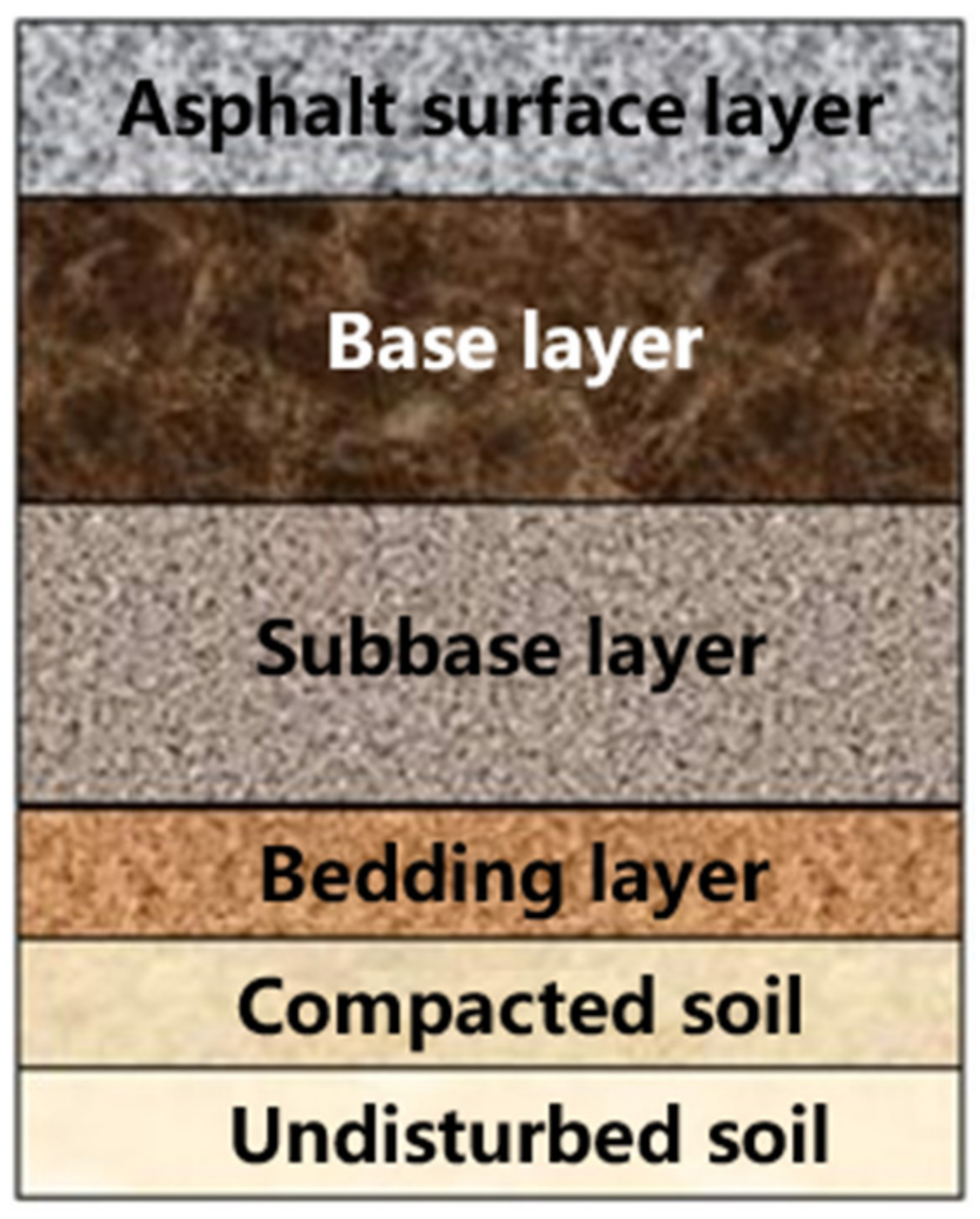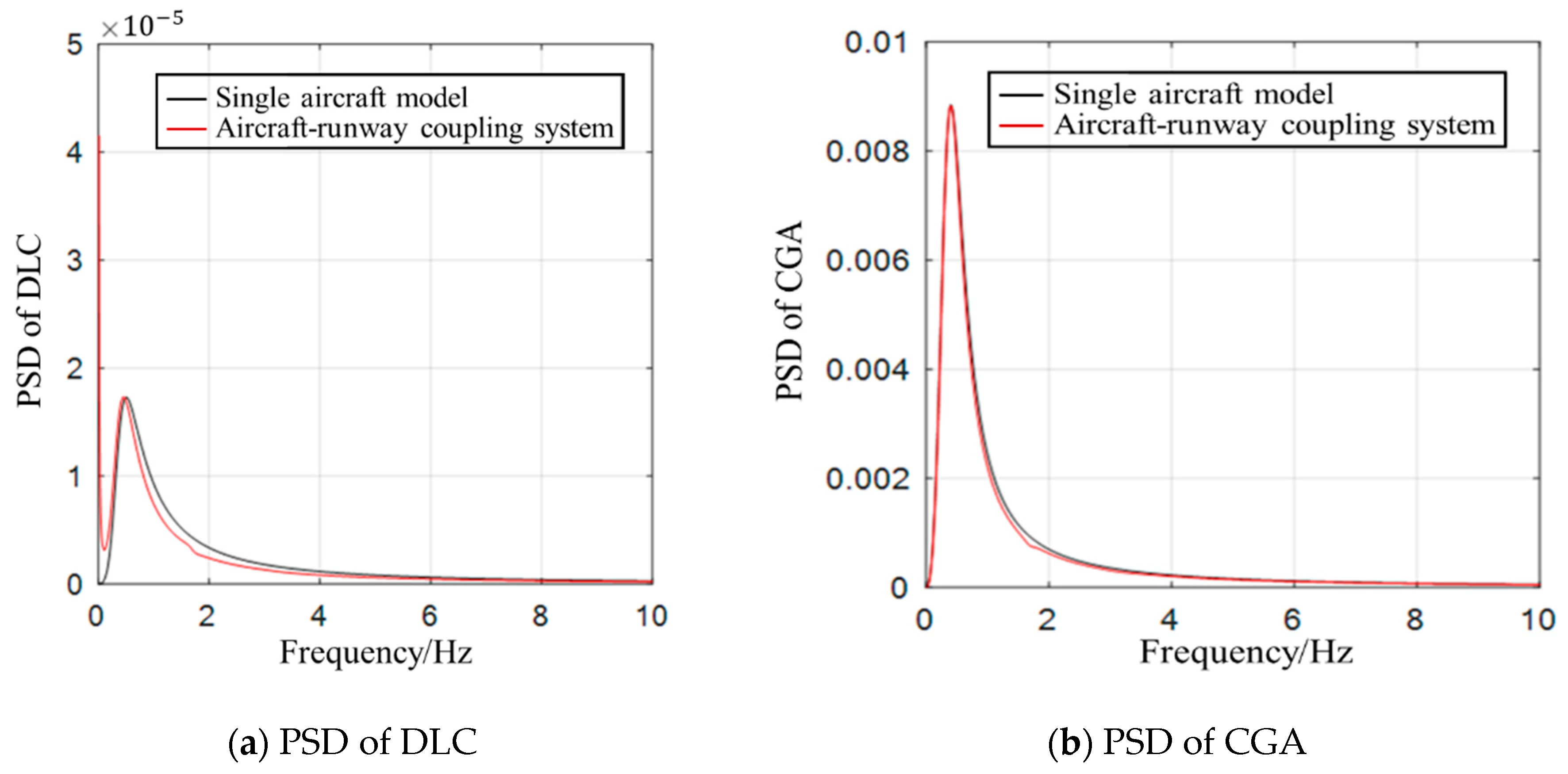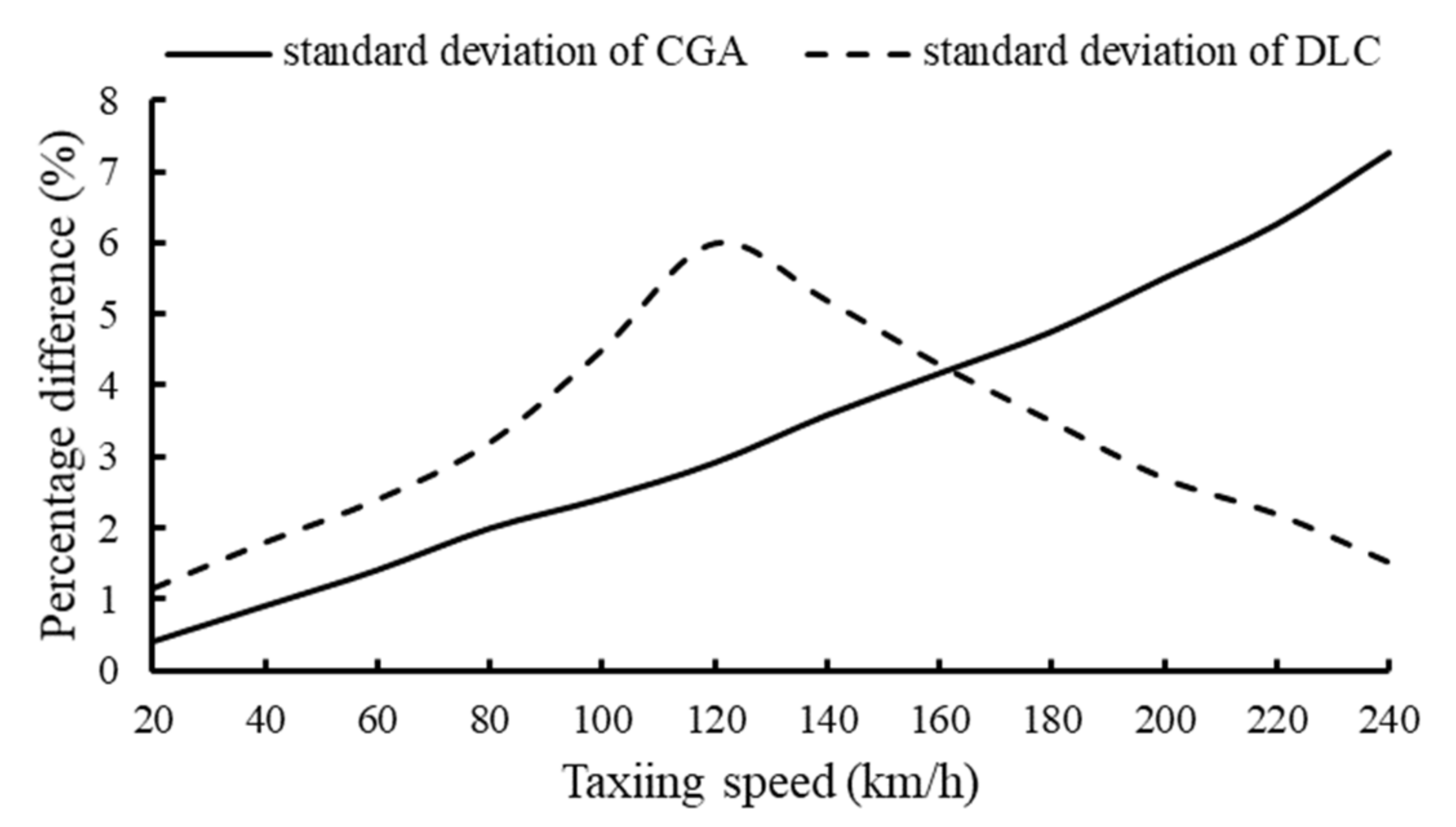Random Vibration Analysis of a Coupled Aircraft/Runway Modeled System for Runway Evaluation
Abstract
:1. Introduction
2. Methodology
2.1. Two Degrees-of-Freedom Aircraft Model
2.2. Vibration Model of Asphalt Runway Structural System
2.3. Dynamics Analysis of Coupled Aircraft/Runway System
2.3.1. Vertical Displacement of Coupled System
2.3.2. Interaction Equilibrium Equations
2.3.3. Response Output
2.3.4. Pseudo Excitation Method Used for Calculations
3. Application Scenarios
3.1. Aircraft Model Parameters
3.2. Asphalt Pavement Runway Model Parameters
3.3. Runway Uneven Excitation Input
4. Results and Discussion
4.1. Calculation of Runway Structural Vibration Modes
4.2. Deformation of Runway Structure
4.3. Effects of Uneven Excitation Parameters on Aircraft Vibration
4.4. Effects of Coupled Effect on Aircraft Vibration
5. Conclusions
- (1)
- A 2-DOF B747 aircraft model and typical asphalt pavement runway structure model are established and their parameters are selected reasonably.
- (2)
- The top four modes of a runway structure, vertical deformation, bending along the longitudinal direction, bending along the transverse direction, and distortion were analyzed and the first-order mode of vertical deformation was found to be the most significant of the four modes.
- (3)
- The uneven excitation parameters for aircraft vibration have a significant effect on the distribution of the vibration responses.
- (4)
- Compared with a single aircraft system, the developed coupled aircraft/asphalt runway system exhibits obvious differences in terms of its dynamic responses, and these differences depend substantially on taxiing speed.
- (5)
- Aircraft lift will affect the DLC. Thus, with an increase in the taxiing speed, the CGA increases gradually, but the DLC increases first and then decreases.
Author Contributions
Funding
Institutional Review Board Statement
Informed Consent Statement
Data Availability Statement
Conflicts of Interest
References
- Gervais, E.L. Runway Roughness Measurement, Quantification and Application: The Boeing Approach; ASCE: Reston, WI, USA, 1991; pp. 121–131. [Google Scholar]
- Loprencipe, G.; Zoccali, P. Comparison of methods for evaluating airport pavement roughness. Int. J. Pavement Eng. 2017, 20, 1–10. [Google Scholar] [CrossRef]
- Emery, S.; Hefer, A.; Horak, E. Roughness of runways and significance of appropriate specifications and measurement. In Proceedings of the 11th Conference on Asphalt Pavements for Southern Africa, Sun City, South Africa, 16–19 August 2015. [Google Scholar]
- Durán, J.B.C.; Júnior, J.L.F. Airport pavement roughness evaluation based on cockpit and center of gravity vertical accelerations. Transportes 2020, 28, 147–159. [Google Scholar] [CrossRef]
- Kuncas, A. New Index Testing and Verification: Runway Roughness Index; Report No. DOT/FAA/TC-21/32, 2021; General Dynamics Information Technology: Egg Harbor Township, NJ, USA, 2021. [Google Scholar]
- Gerardi, M.A.; McNerney, M.T. Temporary construction of ramps and their effect on aircraft ride quality. In Proceedings of the International Conference on Transportation and Development, Pittsburg, PA, USA, 15–18 July 2018; pp. 36–44. [Google Scholar]
- Major, W.; Matthew, J.; Hubbard, S.; Bullock, D. Evaluation of Opportunities for Connected Aircraft Data to Identify Pavement Roughness at Airports. Coll. Aviat. Rev. Int. 2018, 36, 6–20. [Google Scholar] [CrossRef] [Green Version]
- Sivakumar, S.; Haran, A.P. Mathematical model and vibration analysis of aircraft with active landing gears. J. Vib. Control 2015, 21, 229–245. [Google Scholar] [CrossRef]
- Liu, S.; Ling, J.; Tian, Y.; Qian, J. Assessment of aircraft landing gear cumulative stroke to develop a new runway roughness evaluation index. Int. J. Pavement Eng. 2021, 22, 1–12. [Google Scholar] [CrossRef]
- Ling, J.M.; Liu, S.F.; Yuan, J. Applicability of IRI based evaluation of airport pavement roughness. J. Traffic Transp. Eng. 2017, 1, 20–27. [Google Scholar]
- Tian, Y.; Liu, S.; Liu, L.; Xiang, P. Optimization of international roughness index model parameters for sustainable runways. Sustainability 2021, 13, 2184. [Google Scholar] [CrossRef]
- Ruan, F.; Lü, X.L. The stress distribution in airport runway subgrade subjected to airplane moving loads. In Proceedings of the GeoShanghai 2018 International Conference: Transportation Geotechnics and Pavement Engineering, Shanghai, China, 27–30 May 2018; Springer: Singapore, 2018; pp. 262–269. [Google Scholar]
- Tang, C.; Lu, Z.; Yao, H.; Guo, S.; Han, Y. Vibration Characteristics of Unsaturated Runways Under Moving Aircraft Loads. Int. J. Struct. Stab. Dyn. 2021, 21, 2150065. [Google Scholar] [CrossRef]
- Wu, W.; Jia, T.; Xiong, F. Numerical simulation and statistical analysis of random response of the landing gear at taxiing. In Proceedings of the 3rd International Conference on Material, Mechanical and Manufacturing Engineering (IC3ME 2015), Guangzhou, China, 27–28 June 2015; Atlantis Press: Dordrecht, The Netherlands, 2015; pp. 1391–1397. [Google Scholar]
- Lin, J.H.; Zhang, Y.H.; Zhao, Y. Pseudo excitation method and some recent developments. Procedia Eng. 2011, 14, 2453–2458. [Google Scholar] [CrossRef] [Green Version]
- Lin, J.H.; Zhang, W.S.; Williams, F.W. Pseudo-excitation algorithm for nonstationary random seismic responses. Eng. Struct. 1994, 16, 270–276. [Google Scholar] [CrossRef]
- Ling, J.; Liu, S.; Li, M.; Yuan, J. Application limitation of Boeing Bump to evaluation runway roughness. J. Tongji Univ. Nat. Sci. 2017, 45, 23–30. [Google Scholar]
- Qian, J.; Cen, Y.; Liu, D.; Li, J.; Liu, S. Measurement method of all-wave airport runway roughness. J. Traffic Transp. Eng. 2021, 5, 84–93. [Google Scholar]
- Qian, J.; Cen, Y.; Pan, X.; Tian, Y.; Liu, S. Spectrum parameters for runway roughness based on statistical and vibration analysis. Int. J. Pavement Eng. 2021, 22, 1–13. [Google Scholar] [CrossRef]







| Parameters | Values | Parameters | Values |
|---|---|---|---|
| 181,080 kg | 572,500 N·s/m | ||
| 1300 kg | 2,633,277 N/m | ||
| 632,913 N/m | 4066 N·s/m |
| Structural Layer | Thickness (cm) | Resilient Modulus (MPa) | Poisson’s Ratio | Density (km/m3) |
|---|---|---|---|---|
| Asphalt surface | 16 | 1800 | 0.3 | 2400 |
| Semi-rigid base | 20 | 2000 | 0.2 | 2300 |
| Sub-base | 20 | 1500 | 0.2 | 2300 |
| Bedding layer | 34 | 200 | 0.35 | 2000 |
| Soil base | 910 | 60 | 0.40 | 1800 |
Publisher’s Note: MDPI stays neutral with regard to jurisdictional claims in published maps and institutional affiliations. |
© 2022 by the authors. Licensee MDPI, Basel, Switzerland. This article is an open access article distributed under the terms and conditions of the Creative Commons Attribution (CC BY) license (https://creativecommons.org/licenses/by/4.0/).
Share and Cite
Liu, S.; Ling, J.; Tian, Y.; Hou, T.; Zhao, X. Random Vibration Analysis of a Coupled Aircraft/Runway Modeled System for Runway Evaluation. Sustainability 2022, 14, 2815. https://doi.org/10.3390/su14052815
Liu S, Ling J, Tian Y, Hou T, Zhao X. Random Vibration Analysis of a Coupled Aircraft/Runway Modeled System for Runway Evaluation. Sustainability. 2022; 14(5):2815. https://doi.org/10.3390/su14052815
Chicago/Turabian StyleLiu, Shifu, Jianming Ling, Yu Tian, Tianxin Hou, and Xindong Zhao. 2022. "Random Vibration Analysis of a Coupled Aircraft/Runway Modeled System for Runway Evaluation" Sustainability 14, no. 5: 2815. https://doi.org/10.3390/su14052815






